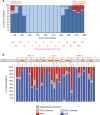Integration of functional assay data results provides strong evidence for classification of hundreds of BRCA1 variants of uncertain significance
- PMID: 33087888
- PMCID: PMC7862071
- DOI: 10.1038/s41436-020-00991-0
Integration of functional assay data results provides strong evidence for classification of hundreds of BRCA1 variants of uncertain significance
Abstract
Purpose: BRCA1 pathogenic variant heterozygotes are at a substantially increased risk for breast and ovarian cancer. The widespread uptake of testing has led to a significant increase in the detection of missense variants in BRCA1, the vast majority of which are variants of uncertain clinical significance (VUS), posing a challenge to genetic counseling. Here, we harness a wealth of functional data for thousands of variants to aid in variant classification.
Methods: We have collected, curated, and harmonized functional data for 2701 missense variants representing 24.5% of possible missense variants in BRCA1. Results were harmonized across studies by converting data into binary categorical variables (functional impact versus no functional impact). Using a panel of reference variants we identified a subset of assays with high sensitivity and specificity (≥80%) and apply the American College of Medical Genetics and Genomics/Association for Molecular Pathology (ACMG/AMP) variant interpretation guidelines to assign evidence criteria for classification.
Results: Integration of data from validated assays provided ACMG/AMP evidence criteria in favor of pathogenicity for 297 variants or against pathogenicity for 2058 representing 96.2% of current VUS functionally assessed. We also explore discordant results and identify limitations in the approach.
Conclusion: High quality functional data are available for BRCA1 missense variants and provide evidence for classification of 2355 VUS according to their pathogenicity.
Keywords: ACMG/AMP guidelines; BRCA1; breast and ovarian cancer; functional assays; variants of uncertain significance.
Conflict of interest statement
M.R. is a full-time, salaried employee of Ambry Genetics. The other authors declare no conflicts of interest.
Figures





References
Publication types
MeSH terms
Substances
Grants and funding
LinkOut - more resources
Full Text Sources
Medical
Miscellaneous

